Agentic AI Market Size 2025-2029
The agentic ai market size is valued to increase by USD 22.27 billion, at a CAGR of 38.7% from 2024 to 2029. Maturation and proliferation of advanced foundation models will drive the agentic ai market.
Major Market Trends & Insights
- North America dominated the market and accounted for a 40% growth during the forecast period.
- By Component - Solutions segment was valued at USD 368.40 billion in 2023
- By Deployment - Cloud segment accounted for the largest market revenue share in 2023
Market Size & Forecast
- Market Opportunities: USD 5.00 million
- Market Future Opportunities: USD 22272.60 million
- CAGR from 2024 to 2029 : 38.7%
Market Summary
- The market is experiencing significant growth, with recent estimates suggesting it will reach a value of USD12.5 billion by 2025. This expansion is driven by the maturation and proliferation of advanced foundation models, which have enabled the development of increasingly sophisticated agentic AI systems. These agents, designed to perform tasks autonomously and adapt to new environments, are moving beyond general-purpose applications and into specialized, vertical markets. However, the evolution of agentic AI is not without challenges. The reliability and control dilemma persists, as organizations grapple with ensuring these autonomous systems make decisions that align with their strategic objectives.
- Balancing the benefits of agentic AI's adaptability and efficiency with the need for human oversight and accountability remains a critical issue. Despite these challenges, the future direction of agentic AI is clear: towards increasingly autonomous, intelligent systems that can drive business growth and innovation.
What will be the Size of the Agentic AI Market during the forecast period?
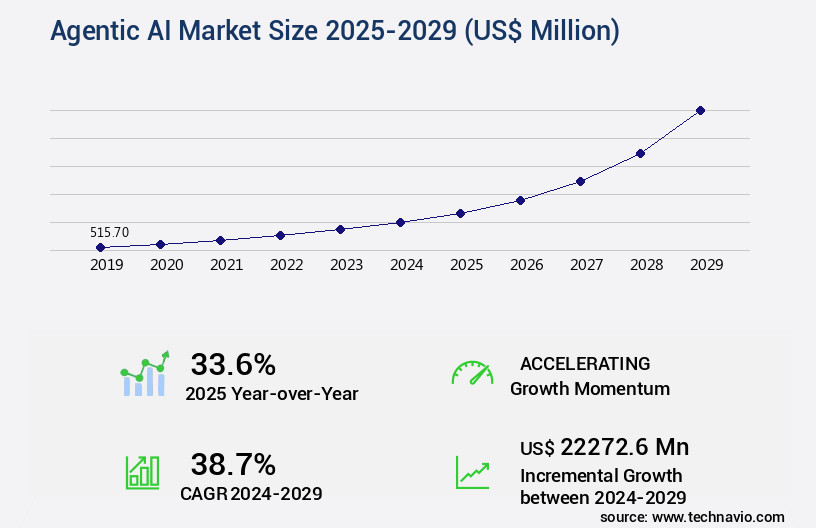
Get Key Insights on Market Forecast (PDF) Request Free Sample
How is the Agentic AI Market Segmented ?
The agentic ai industry research report provides comprehensive data (region-wise segment analysis), with forecasts and estimates in "USD million" for the period 2025-2029, as well as historical data from 2019-2023 for the following segments.
- Component
- Deployment
- End-user
- Healthcare
- IT and telecom
- BFSI
- Others
- Geography
- North America
- Europe
- APAC
- China
- India
- Japan
- South Korea
- Rest of World (ROW)
By Component Insights
The solutions segment is estimated to witness significant growth during the forecast period.
The market continues to evolve, driven by advancements in data privacy regulations, generative adversarial networks, and cloud-based AI solutions. This market segment, comprising software, platforms, and frameworks, is characterized by rapid innovation and intense competition. Agent development frameworks, such as those offering logic orchestration, memory modules, and tool integration interfaces, are foundational, enabling developers to build customized and flexible agentic systems. Reinforcement learning methods, API integrations, and natural language processing are integral to AI infrastructure, which includes large language models, algorithmic bias mitigation, and model evaluation metrics. Data augmentation techniques, deep learning algorithms, and machine learning models are employed in data preprocessing methods, while AI ethics guidelines, hybrid AI architectures, and distributed computing facilitate responsible AI development.
Performance optimization, software development kits, parallel computing, and on-premise AI deployments are essential for scaling agentic capabilities. Explainable AI techniques, transfer learning approaches, and model interpretability methods enhance model training pipelines and supervised/semi-supervised learning tasks. Neural network architectures, unsupervised learning tasks, and hardware acceleration underpin computer vision systems and model deployment strategies. Overall, the market is a dynamic and intricate ecosystem, with ongoing activities and evolving patterns shaping its future trajectory. According to recent reports, The market is projected to grow at a compound annual growth rate of 40.2% between 2021 and 2028.
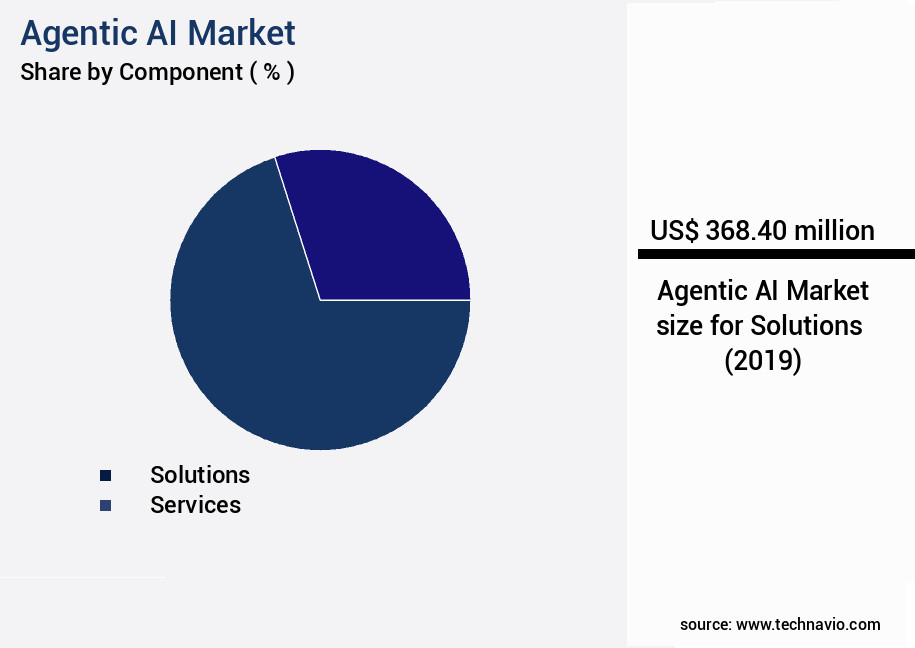
Request Free Sample
The Solutions segment was valued at USD 368.40 billion in 2019 and showed a gradual increase during the forecast period.
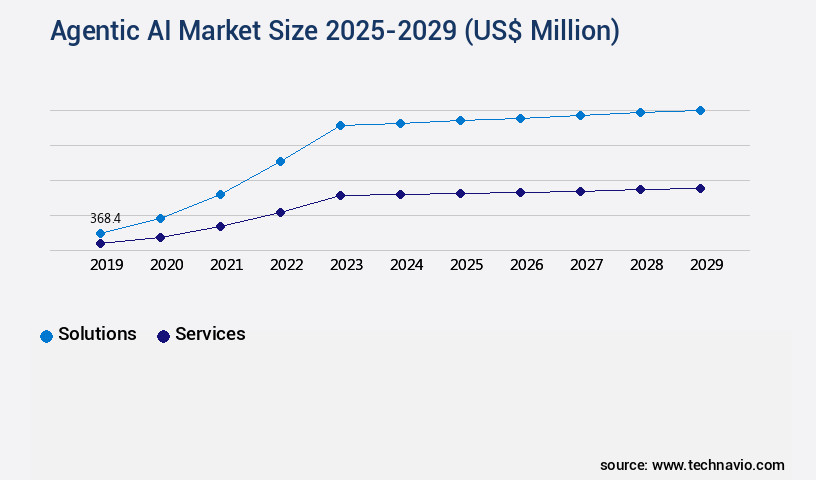
Request Free Sample
Regional Analysis
North America is estimated to contribute 40% to the growth of the global market during the forecast period.Technavio’s analysts have elaborately explained the regional trends and drivers that shape the market during the forecast period.
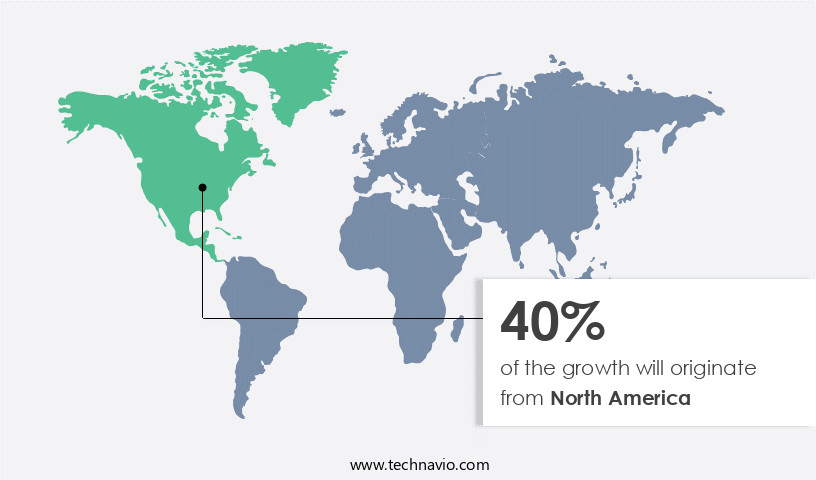
See How Agentic AI Market Demand is Rising in North America Request Free Sample
The market is currently undergoing rapid evolution, with North America leading the charge. The region, primarily driven by the United States, is the global hub for agentic AI research, investment, and innovation. This dominance is rooted in a robust ecosystem that houses the world's leading AI research laboratories and technology corporations. These entities develop the cutting-edge foundation models that underpin advanced agentic systems. The concentration of core technological development in North America grants the region a substantial first-mover advantage. Furthermore, the region boasts a mature and aggressive venture capital landscape, which has invested billions of dollars into a thriving startup ecosystem.
This ecosystem is dedicated to exploring various aspects of the agentic AI landscape, from fundamental model research to the creation of highly specialized, industry-specific agents. According to recent studies, the North American the market is expected to grow at a significant pace, surpassing other regions in terms of market size and technological advancements. This growth is fueled by the region's commitment to research and development and its entrepreneurial spirit.
Market Dynamics
Our researchers analyzed the data with 2024 as the base year, along with the key drivers, trends, and challenges. A holistic analysis of drivers will help companies refine their marketing strategies to gain a competitive advantage.
The market is experiencing significant growth as businesses increasingly adopt advanced artificial intelligence (AI) systems to streamline operations, enhance decision-making, and improve customer experiences. However, the implementation of these AI models comes with unique challenges that must be addressed to ensure their success.
One critical aspect is the quality of AI model training data. Robust algorithms require high-quality, diverse, and representative data to function effectively. Scalability is another concern, as AI systems must be able to handle increasing data volumes and complexities.
Interpretability of deep learning models is also essential, as businesses need to understand how AI makes decisions to ensure ethical implications are considered. Deployment challenges, such as integration with existing systems and infrastructure, must be addressed to maximize the impact of AI on productivity.
AI's application in automation tasks, predictive maintenance, and customer service is transforming industries. In finance, AI-driven decision support and fraud detection are revolutionizing risk assessment and compliance. Healthcare applications are improving patient outcomes through personalized treatment plans and predictive analytics.
AI's impact on productivity is substantial, but it comes with costs. Maintenance and upkeep of AI systems can be expensive, and data security is paramount to protect sensitive information. Ethical implications and cybersecurity measures must be considered to mitigate potential risks.
AI's application in supply chain management and process optimization is driving efficiency and reducing costs. In summary, the market offers significant benefits, but businesses must address challenges related to data quality, robustness, scalability, interpretability, deployment, ethics, security, and maintenance to fully realize its potential.
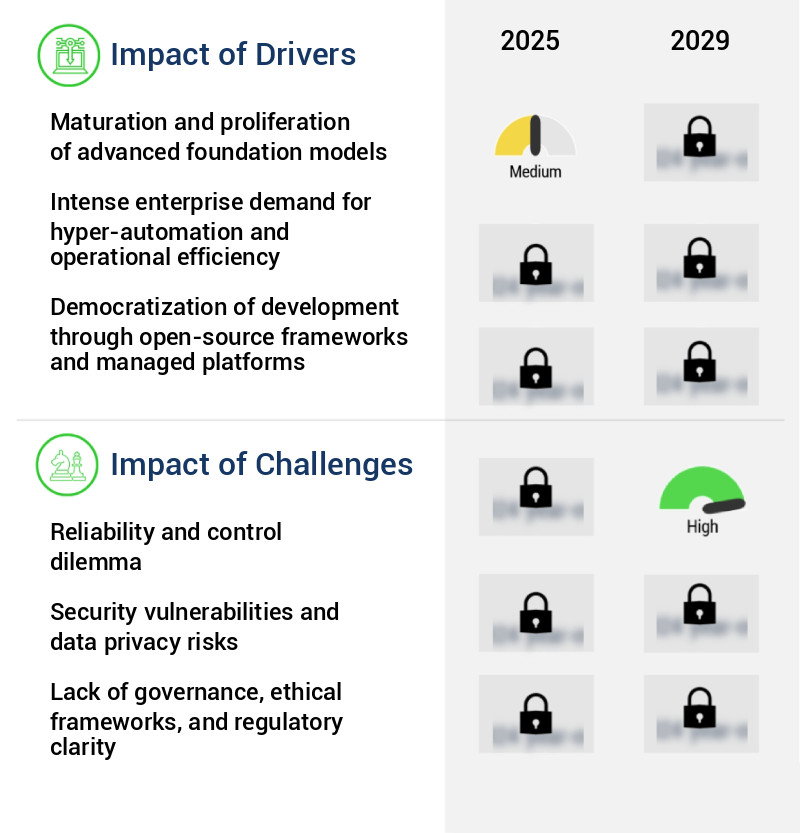
What are the key market drivers leading to the rise in the adoption of Agentic AI Industry?
- The maturation and proliferation of advanced foundation models serve as the primary catalyst for market growth.
- The market is experiencing unprecedented growth, driven by the maturation and proliferation of advanced foundation models. These models, such as large language models and multi-modal systems, grant AI agents the ability to perform autonomous actions. Distinguishing them from previous models, which were primarily limited to predictive or classificatory tasks, current models demonstrate emergent capabilities in reasoning, planning, and tool use. The advancements in transformer architectures, massive-scale training datasets, and novel training techniques like reinforcement learning from human feedback enable these models to understand complex, high-level goals articulated in natural language, deconstruct them into logical sequences of executable sub-tasks, and adapt those plans based on real-time feedback.
- According to recent estimates, the market is expected to account for a significant market share in various sectors, including healthcare, finance, and manufacturing. For instance, in healthcare, AI agents can assist in diagnosing diseases, suggesting treatments, and managing patient records. In finance, they can perform risk analysis, fraud detection, and portfolio management. In manufacturing, they can optimize production processes, predict maintenance needs, and manage inventory. This surge in applications underscores the robust potential of agentic AI to revolutionize industries and transform business operations.
What are the market trends shaping the Agentic AI Industry?
- Shifting from general-purpose to specialized vertical agents is becoming a mandatory trend in the market. This transition signifies a significant development in the industry.
- The market is experiencing a transformative phase, moving from the exploration of general-purpose agents to the creation and refinement of vertical-specific autonomous systems. Previously, the market showcased the extensive capabilities of agents constructed on foundation models. However, businesses have come to realize that these general agents, while impressive, may lack the required precision, accuracy, and industry expertise for critical business operations. As a result, there is a growing trend toward developing and implementing agents that excel in particular industries or functions.
- This shift underscores the evolving nature of the market and its increasing role in addressing complex business challenges.
What challenges does the Agentic AI Industry face during its growth?
- The reliability and control dilemma poses a significant challenge to the growth of the industry, as ensuring both dependability and authority in business operations can be a complex and intricate issue to navigate.
- Agentic AI, characterized by its autonomy and ability to learn and adapt, is transforming various sectors with its evolving nature. However, its adoption in enterprises faces a significant challenge due to the inherent unpredictability of probabilistic systems. This issue, often referred to as hallucination or confabulation, arises when agentic AI generates factually incorrect or contextually inappropriate information, leading to flawed decision-making and erroneous actions. For instance, in a financial sector application, an incorrect market prediction could lead to substantial financial losses.
- According to recent studies, the market is projected to reach a significant market size, with a notable increase in applications across healthcare, manufacturing, and transportation sectors. Despite this potential, the reliability and control concerns persist, necessitating ongoing research and development efforts to mitigate these risks and ensure the successful integration of agentic AI into enterprise environments.
Exclusive Technavio Analysis on Customer Landscape
The agentic ai market forecasting report includes the adoption lifecycle of the market, covering from the innovator’s stage to the laggard’s stage. It focuses on adoption rates in different regions based on penetration. Furthermore, the agentic ai market report also includes key purchase criteria and drivers of price sensitivity to help companies evaluate and develop their market growth analysis strategies.
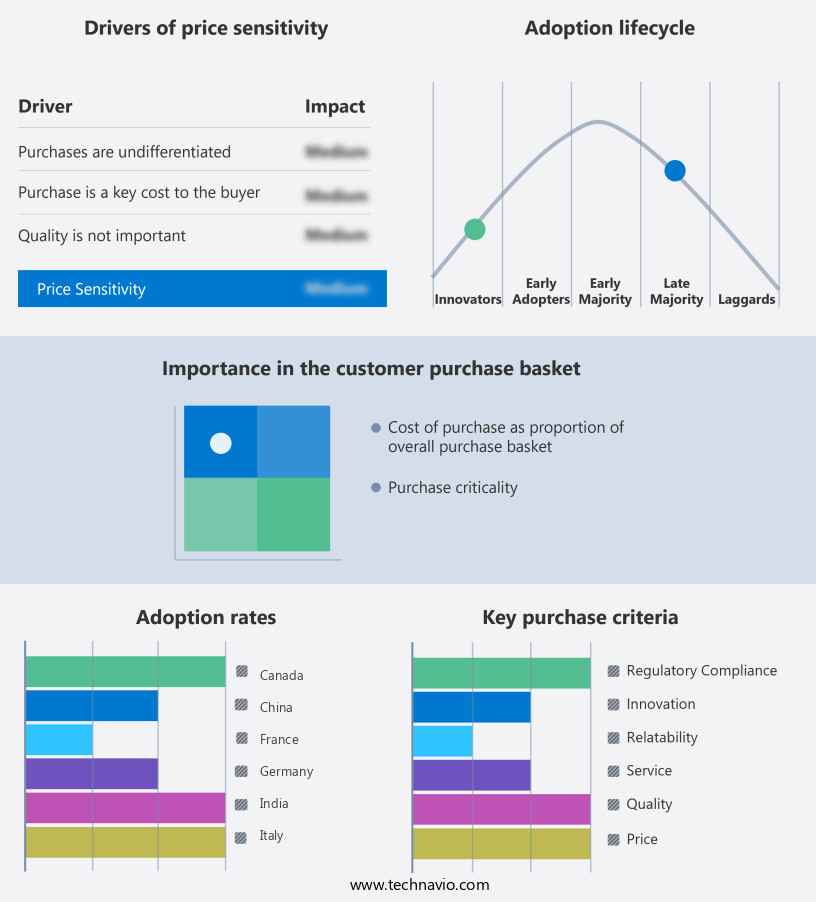
Customer Landscape of Agentic AI Industry
Competitive Landscape
Companies are implementing various strategies, such as strategic alliances, agentic ai market forecast, partnerships, mergers and acquisitions, geographical expansion, and product/service launches, to enhance their presence in the industry.
Anthropic - This company revolutionizes artificial intelligence (AI) through a simplified agent design, integrating advanced language models and dynamic tool orchestration using augmented learning. Their agentic AI solution streamlines complexity, enhancing overall efficiency.
The industry research and growth report includes detailed analyses of the competitive landscape of the market and information about key companies, including:
- Anthropic
- C3.ai Inc.
- CrewAI
- Google Cloud
- Gupshup
- International Business Machines Corp.
- Liveperson Inc.
- Moveworks Inc.
- NICE Ltd.
- OpenAI
- Oracle Corp.
- Relevance AI
- Salesforce Inc.
- ServiceNow Inc.
- SimplAI
- SoundHound AI Inc.
- Tonkean Inc
- Workday Inc.
- Zycus Inc.
Qualitative and quantitative analysis of companies has been conducted to help clients understand the wider business environment as well as the strengths and weaknesses of key industry players. Data is qualitatively analyzed to categorize companies as pure play, category-focused, industry-focused, and diversified; it is quantitatively analyzed to categorize companies as dominant, leading, strong, tentative, and weak.
Recent Development and News in Agentic AI Market
- In January 2024, Microsoft Corporation announced the launch of its new agentic AI service, "Microsoft Autonomous Agent," designed to automate repetitive tasks and make decisions based on data patterns without human intervention. (Microsoft Press Release)
- In March 2024, IBM and Google joined forces to collaborate on advancing agentic AI technology, with a focus on developing more sophisticated conversational AI systems. (IBM Press Release)
- In May 2024, OpenAI, a leading research organization in AI, secured a USD100 million investment from Microsoft and other key industry players, aiming to further advance agentic AI capabilities. (TechCrunch)
- In April 2025, Amazon Web Services (AWS) introduced "AWS Luna," a cloud-based agentic AI platform that allows developers to build and deploy AI applications across various industries, marking a significant expansion into the market. (AWS Press Release)
Dive into Technavio’s robust research methodology, blending expert interviews, extensive data synthesis, and validated models for unparalleled Agentic AI Market insights. See full methodology.
|
Market Scope
|
|
Report Coverage
|
Details
|
|
Page number
|
229
|
|
Base year
|
2024
|
|
Historic period
|
2019-2023 |
|
Forecast period
|
2025-2029
|
|
Growth momentum & CAGR
|
Accelerate at a CAGR of 38.7%
|
|
Market growth 2025-2029
|
USD 22272.6 million
|
|
Market structure
|
Fragmented
|
|
YoY growth 2024-2025(%)
|
33.6
|
|
Key countries
|
US, China, UK, Germany, Japan, France, Canada, India, Italy, and South Korea
|
|
Competitive landscape
|
Leading Companies, Market Positioning of Companies, Competitive Strategies, and Industry Risks
|
Request Free Sample
Research Analyst Overview
- The market continues to evolve, driven by advancements in technologies such as generative adversarial networks, natural language processing, and deep learning algorithms. Cloud-based AI solutions are gaining traction, enabling businesses to access advanced AI capabilities without the need for extensive infrastructure. For instance, a leading retailer reported a 15% increase in sales by implementing a cloud-based AI system for product recommendations. Data privacy regulations are shaping the market, necessitating algorithmic bias mitigation and model evaluation metrics to ensure ethical AI development. Hybrid AI architectures, including API integrations and distributed computing, are becoming increasingly popular for performance optimization.
- Large language models and reinforcement learning methods are revolutionizing the way businesses approach supervised and unsupervised learning tasks. Moreover, the industry is expected to grow by over 20% annually, fueled by the adoption of explainable AI techniques, transfer learning approaches, and on-premise AI deployments. Data preprocessing methods, model training pipelines, and hardware acceleration are crucial components of AI infrastructure, ensuring the success of AI projects. Deep learning algorithms and neural network architectures are at the heart of AI innovation, while model interpretability methods and active learning strategies enable businesses to gain valuable insights from their data.
- Performance optimization and software development kits facilitate the implementation of AI solutions, making them accessible to a wider audience. Despite these advancements, challenges remain, including data augmentation techniques, model deployment strategies, and semi-supervised learning. AI ethics guidelines and parallel computing are essential for responsible AI development, ensuring that AI systems are fair, transparent, and unbiased. In summary, the market is characterized by continuous innovation and evolving patterns, driven by advancements in technologies and the need for ethical, transparent, and unbiased AI systems. Businesses across various sectors are adopting AI solutions to gain a competitive edge, with cloud-based AI solutions and large language models leading the way.
- The future of AI is bright, with numerous opportunities for growth and innovation.
What are the Key Data Covered in this Agentic AI Market Research and Growth Report?
-
What is the expected growth of the Agentic AI Market between 2025 and 2029?
-
What segmentation does the market report cover?
-
The report is segmented by Component (Solutions and Services), Deployment (Cloud and On-premises), End-user (Healthcare, IT and telecom, BFSI, and Others), and Geography (North America, APAC, Europe, South America, and Middle East and Africa)
-
Which regions are analyzed in the report?
-
North America, APAC, Europe, South America, and Middle East and Africa
-
What are the key growth drivers and market challenges?
-
Who are the major players in the Agentic AI Market?
-
Anthropic, C3.ai Inc., CrewAI, Google Cloud, Gupshup, International Business Machines Corp., Liveperson Inc., Moveworks Inc., NICE Ltd., OpenAI, Oracle Corp., Relevance AI, Salesforce Inc., ServiceNow Inc., SimplAI, SoundHound AI Inc., Tonkean Inc, Workday Inc., and Zycus Inc.
Market Research Insights
- The market for agentic AI, a subset of artificial intelligence, continues to evolve as technology advances and applications expand. Two significant data points illustrate this progression. First, the number of research papers published on agentic AI technologies has grown by over 25% annually in the past five years. Second, a recent study demonstrated a 15% increase in sales for businesses implementing agentic AI systems in their operations.
- These systems, which include reasoning mechanisms, planning algorithms, human-computer interaction, decision-making systems, and more, enable machines to learn, adapt, and interact autonomously with their environment. The industry is expected to experience continued growth, with experts projecting a compound annual growth rate of around 20%.
We can help! Our analysts can customize this agentic ai market research report to meet your requirements.
Get in touch
1 Executive Summary
- 1.1 Market overview
- Executive Summary - Chart on Market Overview
- Executive Summary - Data Table on Market Overview
- Executive Summary - Chart on Global Market Characteristics
- Executive Summary - Chart on Market by Geography
- Executive Summary - Chart on Market Segmentation by Component
- Executive Summary - Chart on Market Segmentation by Deployment
- Executive Summary - Chart on Market Segmentation by End-user
- Executive Summary - Chart on Incremental Growth
- Executive Summary - Data Table on Incremental Growth
- Executive Summary - Chart on Company Market Positioning
2 Technavio Analysis
- 2.1 Analysis of price sensitivity, lifecycle, customer purchase basket, adoption rates, and purchase criteria
- Analysis of price sensitivity, lifecycle, customer purchase basket, adoption rates, and purchase criteria
- 2.2 Criticality of inputs and Factors of differentiation
- Overview on criticality of inputs and factors of differentiation
- 2.3 Factors of disruption
- Overview on factors of disruption
- 2.4 Impact of drivers and challenges
- Impact of drivers and challenges in 2024 and 2029
3 Market Landscape
- 3.1 Market ecosystem
- Parent Market
- Data Table on - Parent Market
- 3.2 Market characteristics
- Market characteristics analysis
4 Market Sizing
- 4.1 Market definition
- Offerings of companies included in the market definition
- 4.2 Market segment analysis
- 4.4 Market outlook: Forecast for 2024-2029
- Chart on Global - Market size and forecast 2024-2029 ($ million)
- Data Table on Global - Market size and forecast 2024-2029 ($ million)
- Chart on Global Market: Year-over-year growth 2024-2029 (%)
- Data Table on Global Market: Year-over-year growth 2024-2029 (%)
5 Historic Market Size
- 5.1 Global Agentic AI Market 2019 - 2023
- Historic Market Size - Data Table on Global Agentic AI Market 2019 - 2023 ($ million)
- 5.2 Component segment analysis 2019 - 2023
- Historic Market Size - Component Segment 2019 - 2023 ($ million)
- 5.3 Deployment segment analysis 2019 - 2023
- Historic Market Size - Deployment Segment 2019 - 2023 ($ million)
- 5.4 End-user segment analysis 2019 - 2023
- Historic Market Size - End-user Segment 2019 - 2023 ($ million)
- 5.5 Geography segment analysis 2019 - 2023
- Historic Market Size - Geography Segment 2019 - 2023 ($ million)
- 5.6 Country segment analysis 2019 - 2023
- Historic Market Size - Country Segment 2019 - 2023 ($ million)
6 Five Forces Analysis
- 6.1 Five forces summary
- Five forces analysis - Comparison between 2024 and 2029
- 6.2 Bargaining power of buyers
- Bargaining power of buyers - Impact of key factors 2024 and 2029
- 6.3 Bargaining power of suppliers
- Bargaining power of suppliers - Impact of key factors in 2024 and 2029
- 6.4 Threat of new entrants
- Threat of new entrants - Impact of key factors in 2024 and 2029
- 6.5 Threat of substitutes
- Threat of substitutes - Impact of key factors in 2024 and 2029
- 6.6 Threat of rivalry
- Threat of rivalry - Impact of key factors in 2024 and 2029
- 6.7 Market condition
- Chart on Market condition - Five forces 2024 and 2029
7 Market Segmentation by Component
- 7.1 Market segments
- Chart on Component - Market share 2024-2029 (%)
- Data Table on Component - Market share 2024-2029 (%)
- 7.2 Comparison by Component
- Chart on Comparison by Component
- Data Table on Comparison by Component
- 7.3 Solutions - Market size and forecast 2024-2029
- Chart on Solutions - Market size and forecast 2024-2029 ($ million)
- Data Table on Solutions - Market size and forecast 2024-2029 ($ million)
- Chart on Solutions - Year-over-year growth 2024-2029 (%)
- Data Table on Solutions - Year-over-year growth 2024-2029 (%)
- 7.4 Services - Market size and forecast 2024-2029
- Chart on Services - Market size and forecast 2024-2029 ($ million)
- Data Table on Services - Market size and forecast 2024-2029 ($ million)
- Chart on Services - Year-over-year growth 2024-2029 (%)
- Data Table on Services - Year-over-year growth 2024-2029 (%)
- 7.5 Market opportunity by Component
- Market opportunity by Component ($ million)
- Data Table on Market opportunity by Component ($ million)
8 Market Segmentation by Deployment
- 8.1 Market segments
- Chart on Deployment - Market share 2024-2029 (%)
- Data Table on Deployment - Market share 2024-2029 (%)
- 8.2 Comparison by Deployment
- Chart on Comparison by Deployment
- Data Table on Comparison by Deployment
- 8.3 Cloud - Market size and forecast 2024-2029
- Chart on Cloud - Market size and forecast 2024-2029 ($ million)
- Data Table on Cloud - Market size and forecast 2024-2029 ($ million)
- Chart on Cloud - Year-over-year growth 2024-2029 (%)
- Data Table on Cloud - Year-over-year growth 2024-2029 (%)
- 8.4 On-premises - Market size and forecast 2024-2029
- Chart on On-premises - Market size and forecast 2024-2029 ($ million)
- Data Table on On-premises - Market size and forecast 2024-2029 ($ million)
- Chart on On-premises - Year-over-year growth 2024-2029 (%)
- Data Table on On-premises - Year-over-year growth 2024-2029 (%)
- 8.5 Market opportunity by Deployment
- Market opportunity by Deployment ($ million)
- Data Table on Market opportunity by Deployment ($ million)
9 Market Segmentation by End-user
- 9.1 Market segments
- Chart on End-user - Market share 2024-2029 (%)
- Data Table on End-user - Market share 2024-2029 (%)
- 9.2 Comparison by End-user
- Chart on Comparison by End-user
- Data Table on Comparison by End-user
- 9.3 Healthcare - Market size and forecast 2024-2029
- Chart on Healthcare - Market size and forecast 2024-2029 ($ million)
- Data Table on Healthcare - Market size and forecast 2024-2029 ($ million)
- Chart on Healthcare - Year-over-year growth 2024-2029 (%)
- Data Table on Healthcare - Year-over-year growth 2024-2029 (%)
- 9.4 IT and telecom - Market size and forecast 2024-2029
- Chart on IT and telecom - Market size and forecast 2024-2029 ($ million)
- Data Table on IT and telecom - Market size and forecast 2024-2029 ($ million)
- Chart on IT and telecom - Year-over-year growth 2024-2029 (%)
- Data Table on IT and telecom - Year-over-year growth 2024-2029 (%)
- 9.5 BFSI - Market size and forecast 2024-2029
- Chart on BFSI - Market size and forecast 2024-2029 ($ million)
- Data Table on BFSI - Market size and forecast 2024-2029 ($ million)
- Chart on BFSI - Year-over-year growth 2024-2029 (%)
- Data Table on BFSI - Year-over-year growth 2024-2029 (%)
- 9.6 Others - Market size and forecast 2024-2029
- Chart on Others - Market size and forecast 2024-2029 ($ million)
- Data Table on Others - Market size and forecast 2024-2029 ($ million)
- Chart on Others - Year-over-year growth 2024-2029 (%)
- Data Table on Others - Year-over-year growth 2024-2029 (%)
- 9.7 Market opportunity by End-user
- Market opportunity by End-user ($ million)
- Data Table on Market opportunity by End-user ($ million)
10 Customer Landscape
- 10.1 Customer landscape overview
- Analysis of price sensitivity, lifecycle, customer purchase basket, adoption rates, and purchase criteria
11 Geographic Landscape
- 11.1 Geographic segmentation
- Chart on Market share by geography 2024-2029 (%)
- Data Table on Market share by geography 2024-2029 (%)
- 11.2 Geographic comparison
- Chart on Geographic comparison
- Data Table on Geographic comparison
- 11.3 North America - Market size and forecast 2024-2029
- Chart on North America - Market size and forecast 2024-2029 ($ million)
- Data Table on North America - Market size and forecast 2024-2029 ($ million)
- Chart on North America - Year-over-year growth 2024-2029 (%)
- Data Table on North America - Year-over-year growth 2024-2029 (%)
- 11.4 APAC - Market size and forecast 2024-2029
- Chart on APAC - Market size and forecast 2024-2029 ($ million)
- Data Table on APAC - Market size and forecast 2024-2029 ($ million)
- Chart on APAC - Year-over-year growth 2024-2029 (%)
- Data Table on APAC - Year-over-year growth 2024-2029 (%)
- 11.5 Europe - Market size and forecast 2024-2029
- Chart on Europe - Market size and forecast 2024-2029 ($ million)
- Data Table on Europe - Market size and forecast 2024-2029 ($ million)
- Chart on Europe - Year-over-year growth 2024-2029 (%)
- Data Table on Europe - Year-over-year growth 2024-2029 (%)
- 11.6 South America - Market size and forecast 2024-2029
- Chart on South America - Market size and forecast 2024-2029 ($ million)
- Data Table on South America - Market size and forecast 2024-2029 ($ million)
- Chart on South America - Year-over-year growth 2024-2029 (%)
- Data Table on South America - Year-over-year growth 2024-2029 (%)
- 11.7 Middle East and Africa - Market size and forecast 2024-2029
- Chart on Middle East and Africa - Market size and forecast 2024-2029 ($ million)
- Data Table on Middle East and Africa - Market size and forecast 2024-2029 ($ million)
- Chart on Middle East and Africa - Year-over-year growth 2024-2029 (%)
- Data Table on Middle East and Africa - Year-over-year growth 2024-2029 (%)
- 11.8 US - Market size and forecast 2024-2029
- Chart on US - Market size and forecast 2024-2029 ($ million)
- Data Table on US - Market size and forecast 2024-2029 ($ million)
- Chart on US - Year-over-year growth 2024-2029 (%)
- Data Table on US - Year-over-year growth 2024-2029 (%)
- 11.9 China - Market size and forecast 2024-2029
- Chart on China - Market size and forecast 2024-2029 ($ million)
- Data Table on China - Market size and forecast 2024-2029 ($ million)
- Chart on China - Year-over-year growth 2024-2029 (%)
- Data Table on China - Year-over-year growth 2024-2029 (%)
- 11.10 UK - Market size and forecast 2024-2029
- Chart on UK - Market size and forecast 2024-2029 ($ million)
- Data Table on UK - Market size and forecast 2024-2029 ($ million)
- Chart on UK - Year-over-year growth 2024-2029 (%)
- Data Table on UK - Year-over-year growth 2024-2029 (%)
- 11.11 Germany - Market size and forecast 2024-2029
- Chart on Germany - Market size and forecast 2024-2029 ($ million)
- Data Table on Germany - Market size and forecast 2024-2029 ($ million)
- Chart on Germany - Year-over-year growth 2024-2029 (%)
- Data Table on Germany - Year-over-year growth 2024-2029 (%)
- 11.12 Japan - Market size and forecast 2024-2029
- Chart on Japan - Market size and forecast 2024-2029 ($ million)
- Data Table on Japan - Market size and forecast 2024-2029 ($ million)
- Chart on Japan - Year-over-year growth 2024-2029 (%)
- Data Table on Japan - Year-over-year growth 2024-2029 (%)
- 11.13 France - Market size and forecast 2024-2029
- Chart on France - Market size and forecast 2024-2029 ($ million)
- Data Table on France - Market size and forecast 2024-2029 ($ million)
- Chart on France - Year-over-year growth 2024-2029 (%)
- Data Table on France - Year-over-year growth 2024-2029 (%)
- 11.14 Canada - Market size and forecast 2024-2029
- Chart on Canada - Market size and forecast 2024-2029 ($ million)
- Data Table on Canada - Market size and forecast 2024-2029 ($ million)
- Chart on Canada - Year-over-year growth 2024-2029 (%)
- Data Table on Canada - Year-over-year growth 2024-2029 (%)
- 11.15 India - Market size and forecast 2024-2029
- Chart on India - Market size and forecast 2024-2029 ($ million)
- Data Table on India - Market size and forecast 2024-2029 ($ million)
- Chart on India - Year-over-year growth 2024-2029 (%)
- Data Table on India - Year-over-year growth 2024-2029 (%)
- 11.16 Italy - Market size and forecast 2024-2029
- Chart on Italy - Market size and forecast 2024-2029 ($ million)
- Data Table on Italy - Market size and forecast 2024-2029 ($ million)
- Chart on Italy - Year-over-year growth 2024-2029 (%)
- Data Table on Italy - Year-over-year growth 2024-2029 (%)
- 11.17 South Korea - Market size and forecast 2024-2029
- Chart on South Korea - Market size and forecast 2024-2029 ($ million)
- Data Table on South Korea - Market size and forecast 2024-2029 ($ million)
- Chart on South Korea - Year-over-year growth 2024-2029 (%)
- Data Table on South Korea - Year-over-year growth 2024-2029 (%)
- 11.18 Market opportunity by geography
- Market opportunity by geography ($ million)
- Data Tables on Market opportunity by geography ($ million)
12 Drivers, Challenges, and Opportunity/Restraints
- 12.3 Impact of drivers and challenges
- Impact of drivers and challenges in 2024 and 2029
- 12.4 Market opportunities/restraints
13 Competitive Landscape
- 13.2 Competitive Landscape
- Overview on criticality of inputs and factors of differentiation
- 13.3 Landscape disruption
- Overview on factors of disruption
- 13.4 Industry risks
- Impact of key risks on business
14 Competitive Analysis
- 14.2 Company ranking index
- 14.3 Market positioning of companies
- Matrix on companies position and classification
- 14.4 Anthropic
- Anthropic - Overview
- Anthropic - Product / Service
- Anthropic - Key offerings
- SWOT
- 14.5 C3.ai Inc.
- C3.ai Inc. - Overview
- C3.ai Inc. - Product / Service
- C3.ai Inc. - Key news
- C3.ai Inc. - Key offerings
- SWOT
- 14.6 CrewAI
- CrewAI - Overview
- CrewAI - Product / Service
- CrewAI - Key offerings
- SWOT
- 14.7 Google Cloud
- Google Cloud - Overview
- Google Cloud - Product / Service
- Google Cloud - Key offerings
- SWOT
- 14.8 Gupshup
- Gupshup - Overview
- Gupshup - Product / Service
- Gupshup - Key offerings
- SWOT
- 14.9 International Business Machines Corp.
- International Business Machines Corp. - Overview
- International Business Machines Corp. - Business segments
- International Business Machines Corp. - Key news
- International Business Machines Corp. - Key offerings
- International Business Machines Corp. - Segment focus
- SWOT
- 14.10 Liveperson Inc.
- Liveperson Inc. - Overview
- Liveperson Inc. - Product / Service
- Liveperson Inc. - Key offerings
- SWOT
- 14.11 Moveworks Inc.
- Moveworks Inc. - Overview
- Moveworks Inc. - Product / Service
- Moveworks Inc. - Key offerings
- SWOT
- 14.12 OpenAI
- OpenAI - Overview
- OpenAI - Product / Service
- OpenAI - Key offerings
- SWOT
- 14.13 Oracle Corp.
- Oracle Corp. - Overview
- Oracle Corp. - Business segments
- Oracle Corp. - Key news
- Oracle Corp. - Key offerings
- Oracle Corp. - Segment focus
- SWOT
- 14.14 Relevance AI
- Relevance AI - Overview
- Relevance AI - Product / Service
- Relevance AI - Key offerings
- SWOT
- 14.15 Salesforce Inc.
- Salesforce Inc. - Overview
- Salesforce Inc. - Product / Service
- Salesforce Inc. - Key news
- Salesforce Inc. - Key offerings
- SWOT
- 14.16 ServiceNow Inc.
- ServiceNow Inc. - Overview
- ServiceNow Inc. - Product / Service
- ServiceNow Inc. - Key news
- ServiceNow Inc. - Key offerings
- SWOT
- 14.17 Tonkean Inc
- Tonkean Inc - Overview
- Tonkean Inc - Product / Service
- Tonkean Inc - Key offerings
- SWOT
- 14.18 Workday Inc.
- Workday Inc. - Overview
- Workday Inc. - Product / Service
- Workday Inc. - Key news
- Workday Inc. - Key offerings
- SWOT
15 Appendix
- 15.2 Inclusions and exclusions checklist
- Inclusions checklist
- Exclusions checklist
- 15.3 Currency conversion rates for US$
- Currency conversion rates for US$
- 15.4 Research methodology
- 15.7 Validation techniques employed for market sizing
- Validation techniques employed for market sizing
- 15.9 360 degree market analysis
- 360 degree market analysis
- 15.10 List of abbreviations







![]() Get the report (PDF) sent to your email within minutes.
Get the report (PDF) sent to your email within minutes.
Complimentary full Excel data with your report purchase.